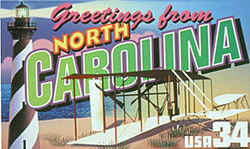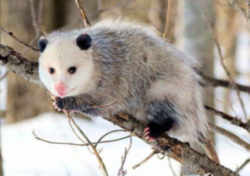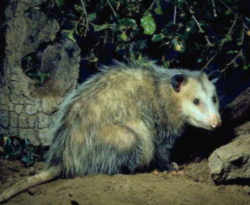
North Carolina Symbols
North Carolina State Marsupial
Virginia opossum

(Didelphis virginiana)
Adopted in 2013.
Session Law 2013-189, signed June 26, 2013, gave North Carolina the following state symbols: state fossil, state frog, state salamander, state marsupial, state folk art, and state art medium.
The Virginia opossum, (Didelphis virginiana,) is the only marsupial found north of Mexico. North Carolina is the only state to have adopted an official marsupial, unless you count Georgia which adopted an official 'Possum in 1992.
North Carolina State Marsupial: Virginia opossum

The Virginia opossum (Didelphis virginiana), commonly known as the North American opossum, is the only marsupial found in North America north of Mexico. In the United States it is typically referred to simply as a possum. A solitary and nocturnal animal about the size of a domestic cat, and thus the largest opossum, it is a successful opportunist. It is familiar to many North Americans as it is often seen near towns, rummaging through garbage cans, or lying by the road, a victim of traffic
Opossums (from the Powhatan Indian word aposoun) are the only marsupials indigenous to North Carolina and the United States. Formerly trapped in great numbers for their fur, which was used for various inexpensive items, they were once confined to the southeastern and south-central United States but are now common from southern Canada to Argentina, even in cities, often becoming agricultural and household pests. The night-roaming opossum eats carrion and deals with threats by displaying its 50 sharp teeth or slipping into fear-induced catatonia ("playing 'possum").
North Carolinians of all races have shunned the opossum as unsanitary, celebrated its comas and illusory cleverness, and considered its meat to be a requisite of gracious living. The opossum hunt, customarily held under a waning autumn moon by groups of men with dogs, artificial lights, and strong drink, was once an important social event in rural areas. Some epicures still consider opossum a delicacy when the animal is taken alive, given clean food to improve its flavor, and baked with sweet potatoes. "'Possum 'n' 'taters" reached the height of respectability in North Carolina during the gubernatorial administrations of William Kerr Scott (1949-53) and his son Robert Walter Scott (1969-73). From 1970 to 1973 the National Hollerin' Contest in Spivey's Corner included a "Prettiest Possum" competition. Public outcry saved the first winner, Slowpoke, from the gubernatorial table.
North Carolina place names inspired by the opossum include Opossum Swamp (Sampson County); two Possum Branches (Macon County); Possum Quarter (Pasquotank County); Possum Neck Swamp (Craven County); Possum Swamp (Pamlico County); Possumquarter (Warren County), the estate of Governor Gabriel Johnston (1699-1751), and its probable namesake, Possumquarter Creek; Possumtown, now Bethany (Davidson County); and Possumtrot Community and Creek (Yancey County).
GENERAL ASSEMBLY OF NORTH CAROLINA
SESSION 2013
SESSION LAW 2013-189
HOUSE BILL 830
AN ACT to adopt an official state fossil, frog, Salamander, marsupial, folk art, and art medium.
Whereas, some of North Carolina's official State symbols have been suggested by the State's school children after they have had history, science, social
studies, or geography lessons related to North Carolina; and
Whereas, this year some of the suggestions range from the adoption of an official fossil to an official frog; and
Whereas, the State of North Carolina has a number of unique official symbols but does not have an official fossil, frog, salamander, marsupial, folk
art, or art medium; and
Whereas, the megalodon shark is an extinct shark species that lived over 1.5 million years ago; and
Whereas, the megalodon shark may have reached over 40 feet in length and weighed up to 100 tons; and
Whereas, the megalodon shark had serrated, heart-shaped teeth that may have grown to over seven inches in length; and
Whereas, fossilized teeth of the megalodon shark have been found in North Carolina and throughout the world; and
Whereas, North Carolina and the Southeast region of the United States lead the world in amphibian diversity; and
Whereas, the pine barrens tree frog can be found in the Sandhills and Coastal Plain regions of North Carolina; and
Whereas, the pine barrens tree frog has been considered one of the most striking and beautiful frogs in the Southeast region of the United States;
and
Whereas, the pine barrens tree frog by name reflects one of North Carolina's signature trees and ecosystems that have been a vital part of the State's
economic, cultural, and natural history since colonial times; and
Whereas, North Carolina also leads the nation and world in salamander diversity, most notably in our Appalachian Mountains; and
Whereas, the marbled salamander is found throughout the State and is unique in that it is a charismatic, striking, chunky-bodied, fossorial amphibian,
of which no two are exactly alike in color pattern; and
Whereas, according the North Carolina Wildlife Commission's 2005 North Carolina Wildlife Action Plan, the pine barrens tree frog and the marbled salamander
have been identified as priority species for population monitoring and conservation in North Carolina; and
Whereas, the Virginia opossum is native to North Carolina and is the only marsupial found in North America; the female carries its underdeveloped young
in a pouch until they are capable of living independently, similar to a kangaroo; and
Whereas, the Virginia opossum is one of the oldest and most primitive species of mammal found in North America; and
Whereas, the Virginia opossum is about the size of a large house cat with a triangular head; a long pointed nose; dark eyes; a long, scaly, prehensile
tail; and short, black, leathery ears; and
Whereas, the Virginia opossum is nocturnal and lives in a wide variety of habitats, including deciduous forests, open woods, and farmland but prefers
wet areas such as marshes, swamps, and streams; and
Whereas, at age 65, Vollis Simpson, a self-taught folk artist, began making giant windmills known as "whirligigs" at his home in Wilson,
North Carolina; and
Whereas, Mr. Simpson's whirligigs have been exhibited at the North Carolina Museum of Art in Raleigh, the High Museum of Art in Atlanta, Georgia, and
the Visionary Art Museum in Baltimore, Maryland, and at other locations, including New York, California, Canada, and England; and
Whereas, Mr. Simpson and details of his artwork have been featured in many national magazines and in several books; and
Whereas, the City of Wilson is developing the Vollis Simpson Whirligig Park to display a large collection of these whirligigs in historic downtown,
which will be a one-of-a-kind destination for visitors; and
Whereas, North Carolina's clay-rich soil has contributed to the State's pottery heritage; and
Whereas, the use of clay has grown from the State's early Native Americans making mostly utilitarian wares and European settlers continuing the traditions
of their ancestors to today's potters designing pottery with utilitarian and aesthetic elements; and
Whereas, the pottery tradition continues to thrive in North Carolina, especially in the Seagrove area, which includes parts of Chatham, Lee, Moore,
Montgomery, and Randolph Counties; and
Whereas, clay continues to be an important art medium contributing to the State's cultural, social, and economic prosperity; Now, therefore,
The General Assembly of North Carolina enacts:
SECTION 1. Chapter 145 of the General Statutes is amended by adding the following new sections to read:
§ 145-41. State fossil.
The fossilized teeth of the megalodon shark is adopted as the official fossil of the State of North Carolina.
"§ 145-42. State frog.
The pine barrens tree frog (Hyla andersonii) is adopted as the official frog of the State of North Carolina.
"§ 145-43. State salamander.
The marbled salamander (Ambystoma opacum) is adopted as the official salamander of the State of North Carolina.
"§ 145-44. State marsupial.
The Virginia opossum (Didelphis virginiana) is adopted as the official marsupial of the State of North Carolina.
"§ 145-45. State folk art.
The whirligigs created by Vollis Simpson are adopted as the official folk art of the State of North Carolina.
"§ 145-46. State art medium.
Clay is adopted as the official art medium of the State of North Carolina."
SECTION 2. This act is effective when it becomes law.
In the General Assembly read three times and ratified this the 20th day of June, 2013.
s/ Philip E. Berger
President Pro Tempore of the Senate
s/ Thom Tillis
Speaker of the House of Representatives
s/ Pat McCrory
Governor
Approved 4:24 p.m. this 26th day of June, 2013
The North Carolina Law
The law designating the Virginia opossum as the official North Carolina state marsupial is found in the The North Carolina General Statutes, Chapter 145, Section 145-44.
CHAPTER 145. State Symbols and Other Official Adoptions.
SECTION 145-44.
"§ 145-44. State marsupial.
The Virginia opossum (Didelphis virginiana) is adopted as the official marsupial of the State of North Carolina.
Taxonomic Hierarchy: Virginia Opossum
Kingdom: Animalia
Phylum: Chordata
Class: Mammalia
Infraclass: Marsupialia
Order: Didelphimorphia
Family: Didelphidae
Subfamily: Didelphinae
Genus: Didelphis
Species: D. virginiana







